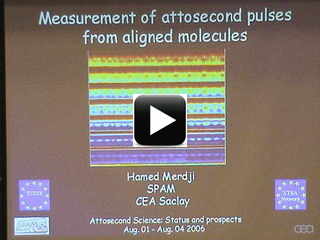H. Merdji, W. Boutu, R. Fitour, P. Monchicourt, P. Bréger, B. Carré and
P. Salières
Service des Photons, Atomes et Molecules, CEA-Saclay, 91191
Gif-sur-Yvette, France
Recently, a number of papers have demonstrated the interest of high-order
harmonic generation (HHG) from molecules aligned with respect to the laser
polarization. Itatani et al. (Nature 432, 867 (2004)) have shown that a
precise characterization of the harmonic emission allows performing a
tomographic reconstruction of the molecular orbitals that radiate. Kanai et
al. (Nature 435, 470 (2005)) have evidenced quantum interferences in the
recombination process of HHG that are directly related to the molecular
structure. In all of these papers, only the HHG intensity was
measured. The relative harmonic phase, though more difficult to
measure, contains important information on the interference process, and is
needed for an ab initio tomographic reconstruction. Finally, while the
attosecond emission from atoms has been thoroughly studied, in particular
by our group (Mairesse et al., Science 302, 1540 (2003)), it has not been
investigated in molecules.
In a recent experiment, we have measured for the first time the harmonic
amplitude and relative phase for aligned molecules. In order to align the
molecules, we used the so-called nonadiabatic technique: a rotational
wavepacket is created by a strong enough and short aligning pulse, so that
a field-free alignment is obtained at the revival (a few ps after the
aligning pulse). The measurement of phase locking between neighboring
harmonics was performed through the photoionization of a target gas by the
harmonic beam in presence of a sufficiently intense "dressing" laser beam
(RABITT technique).
The harmonic emission times measured when the CO2 molecules are aligned
parallel to the generating laser polarization (at the revival of the
rotational wavepacket, 22 ps after the aligning laser pulse) are
significantly different from the Krypton case (which has a similar
ionization potential). Up to sideband 22, their behavior is extremely
similar, with a constant time shift between consecutive harmonic (~100
as). From sideband 22 to 24 this time shift suddenly increases to 350 as
around harmonic 23 in the CO2 case, while it remains the same for the
krypton. Finally a saturation for the last sideband is observed. The
observed time shift around harmonic 23 corresponds to a shift of the
harmonic phase of roughly 2 radians. This is close to the phase jump of pi
that is predicted when destructive interference occurs in the recombination
process. Our measurement would thus be consistent with that of Kanai et
al. (Nature 435, 470 (2005)), where the quantum interference in the
harmonic amplitude was observed around order 23.
The temporal profiles of the generated attosecond pulses has been
reconstructed for both gases. They reveal the complex electron dynamics
involved in the recombination process. While the trains reconstructed from
harmonics 15 to 21 (i.e. before the phase jump) are quite similar, their
comportment differs when one selects harmonics 23 to 29 due to the phase
shift.
Corresponding author: Hamed Merdji, merdji@drecam.cea.fr
 Other video options
Other video options
To begin viewing slides, click on the first slide below. (Or, view as pdf.)
![[01]](tn/01.jpg)
![[02]](tn/02.jpg)
![[03]](tn/03.jpg)
![[04]](tn/04.jpg)
![[05]](tn/05.jpg)
![[06]](tn/06.jpg)
![[07]](tn/07.gif)
![[08]](tn/08.jpg)
![[09]](tn/09.jpg)
![[10]](tn/10.jpg)
![[11]](tn/11.jpg)
![[12]](tn/12.gif)
![[13]](tn/13.jpg)
![[14]](tn/14.jpg)
![[15]](tn/15.jpg)
![[16]](tn/16.jpg)
![[17]](tn/17.jpg)
![[18]](tn/18.jpg)
![[19]](tn/19.jpg)
![[20]](tn/20.gif)
![[21]](tn/21.jpg)
![[22]](tn/22.jpg)
![[23]](tn/23.jpg)
![[24]](tn/24.jpg)
![[25]](tn/25.jpg)
![[26]](tn/26.jpg)
![[27]](tn/27.jpg)
![[28]](tn/28.jpg)
![[29]](tn/29.jpg)
![[30]](tn/30.jpg)
![[31]](tn/31.jpg)
![[32]](tn/32.jpg)
![[33]](tn/33.jpg)
![[34]](tn/34.gif)
![[35]](tn/35.gif)
![[36]](tn/36.jpg)
![[37]](tn/37.jpg)
![[38]](tn/38.gif)
![[39]](tn/39.gif)
![[40]](tn/40.jpg)
![[41]](tn/41.jpg)
![[42]](tn/42.jpg)